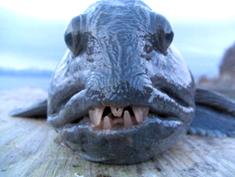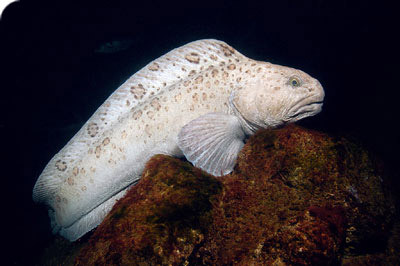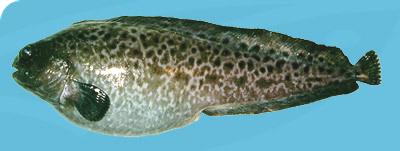
ARC
AS
L'exportation de poisson et de marketing
de la Norvége
http://fish.a-11.com E-Mail : fish@a-11.com
 |
ARC
AS L'exportation de poisson et de marketing |
Norvège temps |
Le
fond de poisson
|
Contact
|
Loup de Mer Latin - Anarhichas lupus (Atlantic) English - Grey Wolffish (Catfish) Norsk - GråSteinbit Deutsch - Katfisch Français - Loup-de-mer / Poisson-Loup / Loup gélatineux Nederlands - Zeewolf Italiano - Gattomare / Wolffish / lupo di mare Español - Perro del norte / Lobo Português - Peixe Lobo riscado / Gata |
 |
|
|
 |
|
Saison
: Mesures : Le poisson : Pêche : Méthode de pêche : Utilisation : |
||
| Spotted Wolffish (Catfish) Latin - Anarhichas minor Norsk - Flekksteinbit Deutsch - Gefleckter Seewolf Français - Loup tacheté Español - Peixe lobo malhado Português - Perro pintado  The Spotted Wolffish has a large rounded head and a compressed body that becomes narrower towards the tailfin. It has strong jaws and feeds on hard shelled animals such as mussels and sea urchins. The spotted catfish has large black spots spread around its body and has a grey-brown to grey-yellow colour. This species is the largest north european catfish,in spite of what the latin name Minor indicates. It is found in the Northeast-Atlantic, westwards along the northern side of the Wyville-Thompson-ridge to Greenland and along the American eastcoast from Labrador to Massachusetts Bay. The spotted catfish or spotted wolffish (Anarhichas minor) is more commonly found in arctic areas. This demersal fish mainly lives at depths of 100 to 550 metres, and spawns in the spring. Season: All year round. Size: As with the other two kinds of catfish, the spotted catfish grows rapidly the first five years, after which the growth decreases. At the age of 7 to 10 years it measures 70-90 cm. Fishing methods are: longlining, gilnetting and bottom trawling. Use: The spotted catfish is distributed fresh or frozen, headed and gutted and as fillet. Its flesh has a firm consistency, so there are many ways to prepare it in the kitchen. It can be cut in strips or bite-sized portions and stir-fried with vegetables, spices and spicy sauces. Wolffish splendid for frying, due to its firm consistency, it is easy to handle on a grill. Nutritional content: The meat is a good source of vitamin A, D and B12, and the total fat content is approximately 2,5%. Commercial product: Fresh spotted catfish Whole fish: • Headed (Head off) and gutted: N-cut (collar bone on) • Packed in polybox (normally of 25 kg) • Size: mix (average weight 1-3 kg) Fillets: • Skinless PBI (Pin Bone In) • Packed in 10 kg polybox (occasionally 5 kg) • Size: mix Frozen spotted catfish Whole fish: • Headed (Head off) and gutted: N-cut • Normally frozen at sea, in vertical freezer • Packed as blocks in carton or bag (of approximately 25 kg), random weight • Size: 1-3 kg/+3 kg Fillets: • Skinless PBI (Pin Bone In) • Frozen at sea in horizontal freezer • Packed in master carton containing 3 blocks, each block weighing 15 pounds(lbs) • Size: 3-5 oz/5-8 oz/8-16 oz/16-32 oz/+32 oz |
| Blue
Wolffish (Catfish) Latin - Anarhichas denticulatus Norsk - Blåsteinbit Deutsch - Blauer Seewolf Français - Loup gélatineux / loup denticulé / loup à tête large Italiano - Pesci Lupo Español - Anarhichadidae Português - Peixe-lobo-azul  The Blue Wolffish has a large rounded head and a compressed body that becomes narrower towards the tailfin. It has strong jaws and feeds on hard shelled animals such as mussels and sea urchins. The blue catfish has a much rounder body shape and a pointier nose than the two other types of catfish (grey and spotted). In addition it has a blue-grayish to dark blue color. This bathypelagic blue catfish is found in the North-Atlantic from the Barents Sea and the western side of Novaja Zemlja to the North Sea and ocean areas off Iceland and Greenland. It thrives at depths of between 60 and 970 meters, and spawns between November and February. Season: All year round. Size: |
Monkfish
/ Anglerfish Season: May 20 to December 20. Nutritional content |
Common
European Skate |
Aiguillat commun Mesures : Le poisson : Pêche : Méthode de pêche : Utilisation : |
Anguille Mesures : Le poisson : Pêche : Méthode de pêche : Utilisation : |